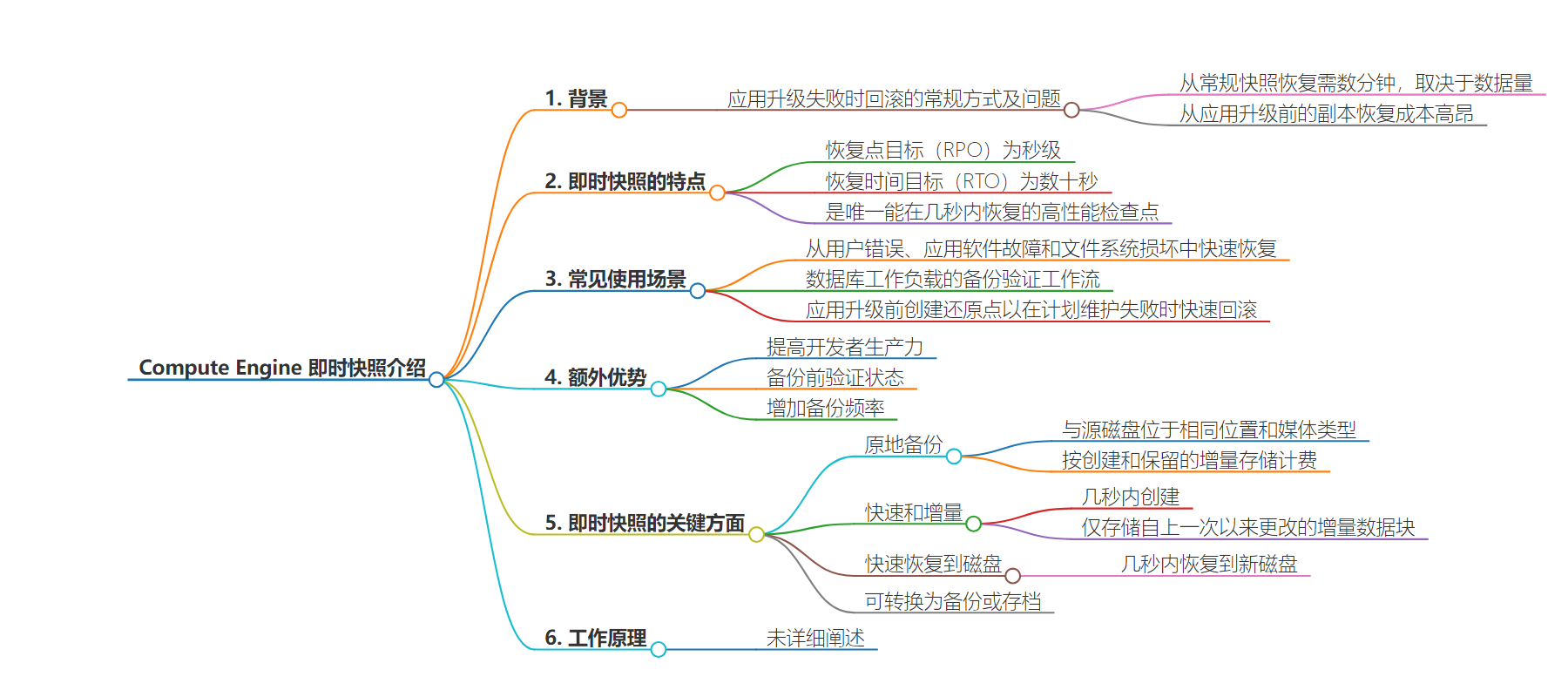包阅导读总结
1. 关键词:Compute Engine、Instant Snapshots、Recovery、Backup、High-Performance
2. 总结:介绍了 Compute Engine 的即时快照功能,它提供快速、高频的磁盘检查点,恢复时间短,成本效益高,且独立于磁盘大小。适用于多种场景,相比传统快照有诸多优势。
3. 主要内容:
– 引入即时快照:应用升级失败需回滚,传统方法有恢复常规快照和从预升级副本恢复,均有不足。
– 即时快照的优势:提供秒级的恢复点目标(RPO)和几十秒的恢复时间目标(RTO),是唯一能在几秒内恢复的超大规模云服务。恢复后立刻全性能运行。
– 适用场景:包括从用户错误、软件故障、文件系统损坏中快速恢复,用于备份验证工作流,应用升级前创建还原点等。
– 额外好处:提高开发者生产力,验证备份状态,增加备份频率。
– 即时快照特点:就地备份,快速且增量式,快速恢复到磁盘,可转换为备份或存档。
– 工作原理:未详细介绍。
思维导图:
文章地址:https://cloud.google.com/blog/products/compute/introducing-compute-engine-instant-snapshots/
文章来源:cloud.google.com
作者:Karthik Satish,David Seidman
发布时间:2024/8/30 0:00
语言:英文
总字数:876字
预计阅读时间:4分钟
评分:86分
标签:计算引擎,即时快照,云计算,灾难恢复,备份解决方案
以下为原文内容
本内容来源于用户推荐转载,旨在分享知识与观点,如有侵权请联系删除 联系邮箱 media@ilingban.com
Imagine you’re an application administrator performing an application upgrade within a one-hour maintenance window, when all of a sudden the upgrade fails. You now want to initiate your rollback procedures. The normal course of action in the rollback is to recover from regular snapshots; this takes several minutes to complete, depending on how much data you have to restore. Or you could look to restore from a pre-upgrade replica of the application — which is expensive to maintain.
What if you had a cost-effective and extremely fast recovery solution that’s independent of disk size, allowing you to use more of the maintenance window and a predictable rollback time?
Today, we are introducing instant snapshots for Compute Engine, which provide near-instantaneous, high-frequency, point-in-time checkpoints of a disk that can be rapidly restored as needed.
Instant snapshots provide a recovery point objective (RPO) of seconds, and a recovery time objective (RTO) in the tens of seconds. Google Cloud is the only hyperscaler to offer high-performance checkpointing that allows you to recover in seconds. Once an instant snapshot is restored, your Compute Engine workload immediately runs with full disk performance, while competing hyperscalers can take tens of minutes or hours before the workload recovers with full performance.
With instant snapshots in Compute Engine, you get recovery in situations where the core infrastructure is intact, but you need to roll back the data to an earlier state. Common use cases include:
-
Enabling rapid recovery from user error, application software failures, and file system corruption.
-
Backup verification workflows, such as for database workloads, that create periodic snapshots and immediately restore them to run data consistency checks.
-
Taking restore points before an application upgrade to enable rapid rollback in the event that planned maintenance was unsuccessful.
In addition to the above, using instant snapshots can also:
-
Improve developer productivity: In rapid development cycles with long build times or complex code, accidental errors and build failures increase time to complete work. With instant snapshots, you can enjoy fast restores without having to resort to off-site backups.
-
Verify state before backing up: Ensure the backups you take are usable and in a desired state. Use instant snapshots to checkpoint and clone disks to verify on secondary machines before initiating long-term backup.
-
Increase backup frequency: With instant snapshots, you can take frequent backups of high-volume, business-critical databases that can’t afford large backup windows.
Key facets of instant snapshots
Compute Engine instant snapshots provide a number of benefits over traditional snapshots.
-
In-place backups: Instant snapshots are taken on zonal or regional disks, and reside in the same location as their source disk and media type. That means that if a disk is of type SDD (or HDD), an instant snapshot created from that disk will be stored on the same disk . Instant snapshots are metered with a fixed charge on creation, as well as for any incremental storage they retain.
-
Fast and incremental: Instant snapshots are created in seconds, and each instant snapshot only stores changed, incremental data blocks since the previous instant snapshot. This allows for high-frequency snapshotting, so you can snapshot much more often compared to backup snapshots.
-
Fast restore to disks: Each instant snapshot can be restored to a new disk in seconds. These new disks are in the same zone as the snapshot and inherit its disk type.
-
Convertible to backup or archive: You can move instant snapshots off to secondary point of presence for long-term, geo-redundant storage.
